[pmb_print_buttons]
Stavanger is the biggest city we’ve seen in a while. In fact there are only 3 cities bigger in Norway – Oslo, Bergen and Trondheim. About 122,000 people live in Stavanger – almost as many as live in Torbay!
Today we are abandoning ship for a smaller (interestingly named) high speed model …
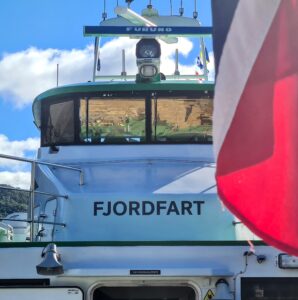
This will take us on a tour of the local waterways and, in particular, Lysefjord.
However, before any real sightseeing could be done we had to have the compulsory coffee and waffle-stop! Moored outside the visitor centre, we saw two large experimental fish farm pens – fish-GLOBEs!
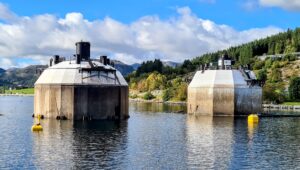
Historically, fish pens have just been large circular netted compounds – and during our time in the fjords we have seen hundreds of them – at least 20 this morning.

There are a number of significant problems with these nets. There is huge organic contamination below the nets, fish lice can (and do) infect the crowded populations and antibiotics used to treat the fish are released into local waters. Escaping fish themselves constitute a serious risk to wild populations – they are bred for rapid growth and not for competitive life in the wild.
FishGLOBEs, are made out of polyethylene (HDPE) and float. They have sophisticated monitoring and control systems with automated feeding. The early globes were each 3,500 cubic metres with capacity to grow 250,000 post-smolt salmon to a weight of one kilogram. Later versions are larger and enclose 7,000 cubic metres of water. However, I bet they cost a great deal more than kevlar nets! And big net pens can be over 50,000 cubic metres and contain over a million salmon – so there’s an issue of scale here!
Onwards! There is only one crossing of the Lyesfjord, but can you see it? …
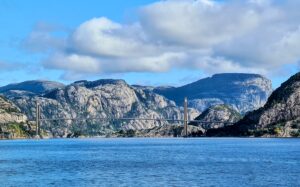
… and the village, Lysebotn, at the end of the 42 km fjord is listed as “rather isolated” (clearly not my photo – thank you internet!)
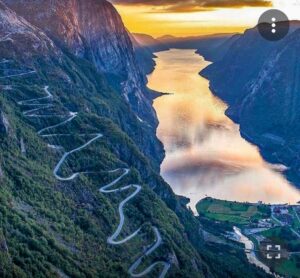
In my book, any village served by a single road like that (with its 27 hairpin bends) is entitled to be called “rather isolated”! Of course the residents could always row in and out!
Along the walls of the fjord there were hundreds of waterfalls –
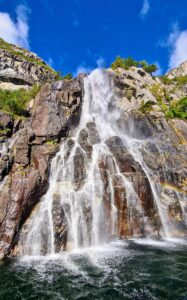
… and we sailed through the spray of some…
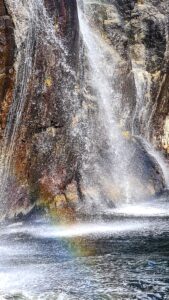
Then we came to Preikestolen (also known as Pulpit Rock). This is a steep cliff which rises 604 metres above Lysefjord At the top of the cliff, there is an almost flat area of approximately 25 by 25 metres.
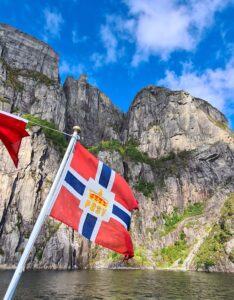
You can just see it, immediately above the tip of the flag pole. And in close up …
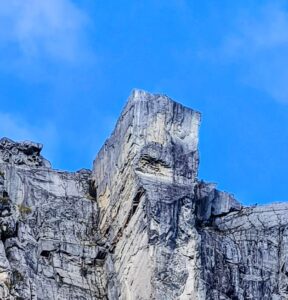
When you consider there is three quarters as much rock face below the water (450 m) as above, you get a feeling for the magnitude of this mountain face.
While stunning from the water, it is apparently one of Norway’s most hiked-to destinations. In the season 5,000 people a day visit the rock. There were dozens up there the day we visited. All standing close to the edge of the flat area looking away from the precipice and the view while taking selfies for Twitter etc.!
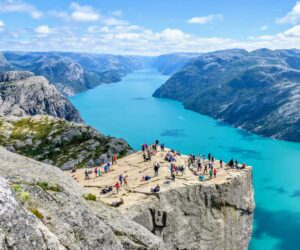
(Clearly not my photo, but I count at least 85 people on the rock including one toddler!)
The 3.8 km walk to Pulpit Rock takes about four hours to complete. That seems a long time. There’s a clue to this apparent slow pace when you hear that in 2013 the route was “improved by Nepalese sherpas”! Yeah right. Take the boat!
Funnily, I could have sworn that Pulpit Rock was on the North wall of the fjord. But it’s not, the boat must have turned round when I wasn’t concentrating! In my defence, there was a lot of distracting scenery about!
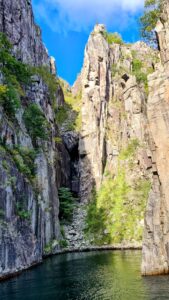
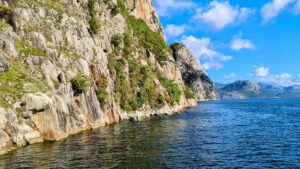
On the way back to Stavanger, we passed back through the narrow fjord entrance where the water is only 13 m deep (that’s terminal moraines for you!) …
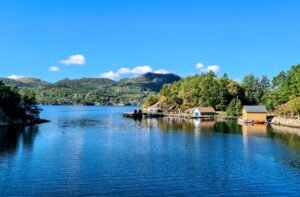
This really is a great trip – especially in the fabulous weather we hit upon! There are lots of islands and summer houses on the way “home” for tea.
One more edition to follow!
